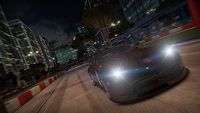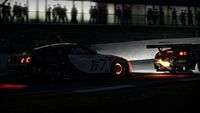Shift 2 Unleashed Preview and Interview
by Dom
With Need For Speed: Shift 2 Unleashed – to be honest, on first impressions, I was just expecting another standard Need For Speed game. Having put a lot of time into the Hot Pursuit series recently, I was just expecting a shiny, new version of the same game with a few new gimmicks thrown in for good measure.
The most notable thing about Shift 2 is the controls. As soon as the GL Team (that is me and cameraman Pete) arrived at the event, we were able to get a solid amount of hands-on time with the debug code of the game. My initial rampages through the tracks on offer were poor – sliding off on corners, braking at completely the wrong time, accelerating right into the polished bumper of all the cars in front of me. I was playing it too much like Hot Pursuit – like it was another generic chase-em-up driver.
You will invariably get punished for doing this; if you don’t take this game seriously, it will chew you up, spit you out and run you over. The slightest hesitation around a tight corner will see you either slamming side-on into a competitor’s car or kissing the embankment with your headlights. Try to cut the corner of a track and you’ll lose grip on the surface, decelerate and drift causelessly into the road. The game is responsive and brutal – every single brush on the directional stick has consequences, and every gram of pressure on the brake or acceleration triggers is measured.
Once you get used to the controls (and it will take some getting used to; this is no Forza with its forgiving Driver Assists), the game opens up to you and you get to explore just how much thought has gone into every single aspect of the gameplay. The physics engine was built from the ground up: input from professional drivers was key to the development of how the cars handled. Shift 2 has the most advanced physics engine of any driving game… and it tells.
Each tyre, for example, has an in-depth measure of its grip, friction and speed that are all calculated hundreds of times a second. The aerodynamics of the car are taken into account, and the surfaces of each track and the sand-traps all have different – and realistic – effects on your experience. The best use of the physics, in my opinion, is the from driver’s view Helmet Cam: your vision is the exact same as a driver’s would be in the race, down to every jolt from braking and every turn on the corner. When you drift, your head automatically turns to look at the window in the direction you’re going. When you slam the brakes on, your head is forced forward with the effect of G-force. Everything is tangible and real, and it is the most accurate representation of the driving experience that I (who doesn’t drive) have experienced in a game.
 To show us just how much work has gone into making the racing experience so realistic, EA took us out onto the Silverstone track in an Aston Martin V8 Vantage. Now, these words could make certain sectors of the gaming community giggle like little schoolgirls; the car is something of an icon among racing enthusiasts. It’s light, responsive, fast and pretty. It handles like a dream, and there is just enough understeer to make it worth driving. The corners get eaten up with ease beneath the grip-friendly tyres and accelerating out of even the tightest hairpin turn can force you back into your seat. The car is under no illusion of its power – this isn’t the most intense car in the world, and it knows that. It has just enough power to tear around the Silverstone Grand Prix circuit in about one minute and make you giddy with excitement when you step out of the car.
To show us just how much work has gone into making the racing experience so realistic, EA took us out onto the Silverstone track in an Aston Martin V8 Vantage. Now, these words could make certain sectors of the gaming community giggle like little schoolgirls; the car is something of an icon among racing enthusiasts. It’s light, responsive, fast and pretty. It handles like a dream, and there is just enough understeer to make it worth driving. The corners get eaten up with ease beneath the grip-friendly tyres and accelerating out of even the tightest hairpin turn can force you back into your seat. The car is under no illusion of its power – this isn’t the most intense car in the world, and it knows that. It has just enough power to tear around the Silverstone Grand Prix circuit in about one minute and make you giddy with excitement when you step out of the car.
We were taken around two laps of the circuit with a professional driver. At night. That’s another main focus of the game – night racing. You lose all sense of perspective at night; you don’t see the corners coming up until the last minute and you have to improvise on your braking points. As you power down a long straight, you tense up because – with all the assists turned off – you have no idea when you need to start preparing for the corner. This was exactly the same on the laps we did in the V8 – the driver told us he knew the track like the back of his hand, yet he still had to think on his feet to get the right braking points.
In the car itself, I had to brace my feet against the foot-well and brace my arms against the ledge of the window to avoid being thrown around like an airy rag doll. What amazed me the most was the way the driver, who had to keep his feet free for the pedals, stayed completely static, not even leaning to the side in the corners. The amount of strength you need in your upper and lower body to do that is insane. When we hit the last corner, the driver threw a four-second drift in. The feel of the car was fantastic – you could feel the tyres trying to get purchase on the road but the sheer force of the momentum acting on the V8’s tail pushed it along. The car then kicked back into life and came out of the drift without so much as a hitch – the acceleration back onto the road didn’t suffer in the slightest.
We were taken back into the Event Room and told all the games had been set to play ONLY Aston Martin V8 Vantages on Silverstone Grand Prix circuit at night. Sitting down at one of the stations, I booted up the race. Now that I had the real experience to compare the race to, I thought I might just be able to perform a little better than I had been earlier. The first thing I noticed was how responsive the Helmet View camera was – Slightly Mad Studios have hit the nail on the head with that one. The way the AI chooses to direct your vision is exactly as you would in the car yourself, and you never find yourself having to quickly tap between cams to get a sense of your bearings – your view finds what you need without hesitation. I remembered (sort of) the line the driver took out on the track and tried to emulate it as closely as I could. Now, unlike Forza, the ‘Best Line’ assist on Shift 2 doesn’t necessarily give you the ‘Best Line’ – the AI are aggressive and intuitive; they will respond to you coming up on their tail by making it harder for you to overtake. If you just follow the best line, you won’t win – you need to be brave and accelerate out of the corners quickly or brake later. The assist is there purely as guidance; it’s a skeleton of what you need to do in the race.
Another thing I noticed when playing with the Vantage is that it handles completely differently from the other cars we used. In fact, every single car is different. Some steer like idiots but pick speed up quicker, some forsake acceleration for better handling. All the cars feel like their real-world counterparts, and the difference between them can be staggering. I chose a Bugatti Veyron for my first go on the game, and decided to take it around Donington Park (my hometown, you see). I am ashamed to say I flipped the car. Twice. Putting it on a bigger circuit solved my problems (a little). I downsized the car and chose the Vantage after a few laps of totalling the £500,000 Veyron. Instantly, my game improved – Shift 2 is one of those decent racers where you have to learn how to use it before you dive in with the big boys: a few more laps in the Vantage and I could just about handle the Veyron.
 |
 |
 |
 |
 |
 |
At the start of the event, I heard a lot of people complain about the handling. It was quite a put off. But when you think about playing the game fresh – come at it like a brand new driving game, and not part of a franchise – it works much better. It strips down everything that racing games think they are and builds back up on it. This is what the genre needs – the game is innovative, different and a real treat for Core gamers. This is more of a driving sim than an out-and-out racer, but everything that’s gone into the build of the game tailors it for the realistic experience, rather than the ridiculous and exaggerated chases of Hot Pursuit.
Graphically, the game is what you’d expect from EA, and the Need for Speed franchise in particular; the surfaces of the cars are shiny and look as cool as they do in the flesh, the tracks themselves look fresh and crisp – like they’ve just been re-laid. If you smash your car on another racer or tyre wall, you can see the debris on the road in perfect detail – crushed little cubes of glass, shreds of torn paint and individual blades of grass can all be seen (if you look hard enough). When you top 120mph, motion blur begins to frame the screen – pretty standard in racers these days, but still a nice effect. If you look to the stands during the race, however, you’ll be a little disappointed – apparently stadium mechanics haven’t evolved since Sega Rally Championship for the Sega Saturn; the sprites are all still stick-like and 2D.
Aurally, the game delivers much as you’d expect: engine roars, tyre screeches and the occasional clunk of something bad happening in your car if you push it too hard (read: roll it). The intercom from the Control Room can be genuinely entertaining, though if you hear “you’ve gotta push hard through the second corner” too many times, you are likely to go insane.
 As far as innovation goes, there is a lovely little feature called the AutoLog – this automatically uploads all your map times, ghosts and driver info whenever you want it to. If your PSN or Live friends play a lot of racers, you will find yourself booting the game up merely to win back your place on the leaderboards (again). The way your driver levels up is nice, too; instead of just getting XP for winning, you get rewards for following the best line, mastering corners, being in front… anything that would benefit you in real life benefits you in-game, too. The night racing feature is nice, too – and from the experience I had on-site, I can say they’ve pretty much caught the feeling of it perfectly. Night racing is a big focus in the game; even one of the achievements is to complete every event at night, granting you a massive 100G reward.
As far as innovation goes, there is a lovely little feature called the AutoLog – this automatically uploads all your map times, ghosts and driver info whenever you want it to. If your PSN or Live friends play a lot of racers, you will find yourself booting the game up merely to win back your place on the leaderboards (again). The way your driver levels up is nice, too; instead of just getting XP for winning, you get rewards for following the best line, mastering corners, being in front… anything that would benefit you in real life benefits you in-game, too. The night racing feature is nice, too – and from the experience I had on-site, I can say they’ve pretty much caught the feeling of it perfectly. Night racing is a big focus in the game; even one of the achievements is to complete every event at night, granting you a massive 100G reward.
From the build of the game I played, I can say that Shift 2 is definitely a breath of fresh air to a relatively static genre. There isn’t a lot you can alter about the premise of a racer – choose a car, drive the track, win – but Slightly Mad are looking more at the experience and making you feel like you’re actually in the driving seat.
And from what I’ve played so far, they’re definitely succeeding.
Interview
Many thanks to Andy Tudor from Slightly Mad Studios for taking the time out to talk Shift 2 with us at Silverstone…
Last five articles by Dom
- Defining Games, Part I: ‘Culture’
- Best of 2012 - 10 Games and Their Classic 8-Point Story Arcs
- 10 Games and Their Classic 8-Point Story Arcs
- Tekken Tag Tournament 2 - Review
- Tom Clancy’s Ghost Recon: Future Soldier - MP, Campaign, and Film Preview






















Had a play on this last month. It looked great but I think my controller was broken, or I happened to suck at steering Cool read.
Cool read.
Same as Kat I got the chance to play this in Feb and really got punished for just walking straight up to it and trying to take what I already knew about racing games and channel it into my thumbs.
It’s brutal but after a few laps you really do find yourself understanding the game a lot more and playing around with it’s mechanics. You start to ignore the driving assist lines and just focus on driving how the car feels like it needs to be driven.
Great write up Dom and nice of Andy to take the time to talk to us. He gave the talk at the Guardian event in preview of this and was a real nice, friendly and forward guy
Man, I’m totally torn on this one, it has to be said. I love jumping in to a virtual car and blasting around at high speeds, especially when you can FEEL the speed… and the whole idea of the helmet cam makes me kinda moist just thinking about it, because it would be the closest I’d ever come to being in the car, since I can’t drive. The fact that they’ve gone to so much effort to handle all the physics of the tyres on the road, the pull as it tears around corners etc makes me think that it would be a stunning game to play.
BUT.
I hate tracks. When I’m racing, I prefer it to be the open road where you get to rip through corners like there’s no tomorrow, avoiding obstacles here and there and just getting the feel of DRIVING rather than racing specifically. I’ve played so many driving/racing games and not got on with them because they’re circuit based and from what I can see here that’s the same with Shift 2. That said, I’m still really interested in experiencing the immersion of the helmet cam so I may still give it a shot. We’ll see.
I’ll be getting this one, haven’t managed to find a racing sim I’ve been happy with since GT2. Forza 2 was good but just felt boring after a while and I seem to have spent all my time in Forza 3 painting cars rather than racing. The first Shift was a step in the right direction but it’s career mode was a bit oddly structured and I got to the end to quick, that and the A.I. drivers were bleeding crazy! If those things got fixed then I can see me playing this for many a month.
and night racing round Silverstone in an Aston Martin! You lucky, lucky bas….
I got to play the game in february and saw the potential there but dismissed it not because of the game itself, but me. I wouldn’t be skilled enough or have enough time to master this sort of game, and so I reluctantly have to give it a miss.
Eternally jealous of the being driven around silverstone thing. You lucky, lucky person.
What a fantastic event – lucky bastard, this sounded like a great experience, I think the night time aspect made it that much more appealing. As far as the game goes, I prefer Burnout Paradise type driving action – I loathe track based racers, as appealing as they can be made and as luxurious as the graphics might be, I just find the thought of them a touch boring. However, with that said, the game sounds pretty impressive, with the sheer effort to preserve realism that has gone into the vehicles and handling; interesting stuff! I suspect I’d roll any vehicle more times than a cheese thundering down a hillside…